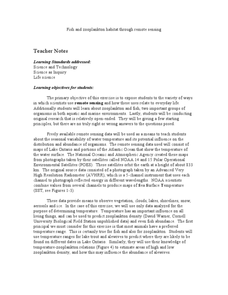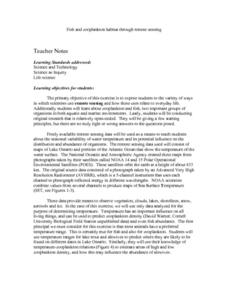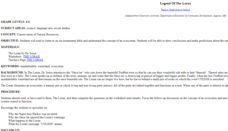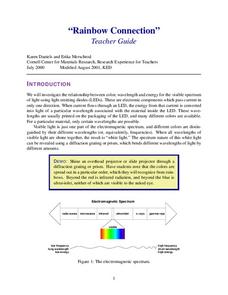Cornell University
Wasps and Ladybugs
Can a good bug ever become a bad bug? An elementary entomology resource explores what to do when too many ladybugs or too many bees are in your home and can become a problem.
Curated OER
Recording the Deed: Note-Taking on Heroes
Students prepare to write summaries of heroes. In this note-taking lesson plan, students listen to a guest speaker discuss the attributes of unsung heroes and take Cornell method notes.
Curated OER
Putting it all Together
Students take notes and summarize information. In this communication lesson, students summarize information by taking notes using the various methods that their instructor presents to them.
Curated OER
Format for Notes
In this study skills instructional activity, students use the template for reading, taking notes, recording questions, identifying topics and main ideas to enhance study skills and increase comprehension of reading assignments.
Curated OER
Bill Of Rights
High schoolers examine Supreme Court cases. In this U.S. government lesson, students watch a video about the Bill of Rights and then research 4 Supreme Court cases using the noted web site. High schoolers analyze the presented...
Santa Ana Unified School District
The Giver
Wouldn't it be great to live an a community without pain, without danger? Such a society is the goal of the community in The Giver. Using Lois Lowry's dystopian novel as the core text, class members read primary source materials...
Curated OER
Enlightenment Notes
In this Enlightenment study guide worksheet, pupils read over notes and create Cornell questions to accompany them. Students also respond to 3 short answer questions.
Curated OER
Fish and Zooplankton Through Remote Sensing
Ecology aces examine sea surface temperature maps and relate temperatures to concentration in fish and zooplankton populations. Take your class to a computer lab and provide experience with actual remote sensing data. Some of the links...
Curated OER
Lake Strata and Internal Waves
Use the classic density demonstration of placing a cola, a clear soda, and a diet soda into a tank of water. Then let learners attempt to pour some of the soda into layers in a clear container. The procedure explains a thermocline, and...
Curated OER
Fish and zooplankton habitat through remote sensing
Students are exposed to the variety of ways in which scientist use remote sensing and it used in everyday life. They investigate about zooplankton and fish. Students list the two important groups of organisms in both aquatic and marine...
Curated OER
Identity Boxes
Students create a "portrait" box that contains symbolic representations of their own identity. In this Lucas Samaras and Joseph Cornell art lesson, students discover ways that these two artists used symbols and objects to represent...
Everett Public Schools
High School Writing: Student Guide
Here's an amazing writing guide that deserves a place in your curriculum library. The 136-page packet provides focus lessons on the writing process, expository, persuasive, and timed writing, the Cornell system of note taking, and...
Curated OER
Simple Machines
Eighth graders work together in groups to introduce themselves to the six types of simple machines. They are to record what the machine does, its mechanical advantage and identify real world situations in which they are used. They...
Curated OER
Refining the Why? Turning Student Questions into Research
Middle schoolers have years of experience when it comes to how their bodies work. Surely they have some questions as well. Here is an opportunity for them to practice the scientific method in an attempt to answer some of those questions....
Curated OER
Speak Up for Recycling
Are you looking for ways to enhance a persuasive writing or speech unit? Use this lesson to prompt your young writers to investigate a school recycling program. After conducting research, they present a persuasive, well-organized speech...
Curated OER
Legend of The Lorax
Students explore ecosystems. They read or listen to Dr. Seuss' The Lorax to draw conclusions and make predictions about the environmental impact and use of resources. They write poems about real forests and the wildlife which inhabit...
Curated OER
Developed v. Developing Countries
In this developed and developing countries Cornell question worksheet, young scholars use the notes provided to create a note card for study purposes.
Curated OER
Africa 1945-Present
In this Africa 1945-present fact card worksheet, students use the notes and picture provided to create a note card for study purposes.
Curated OER
World Interdependence
In this world interdependence fact card worksheet, students use the notes regarding world organizations and trade agreements provided to create a note card for study purposes.
Curated OER
1.2 Points, Lines and Planes
This is a lengthy overview PowerPoint that defines, explains, shows examples, and has practice problems about points, lines and planes. The class will need to write many notes and there is an example of how to set up in the Cornell...
Curated OER
Discovering Pi
Sixth graders measure circumference and diameter to the nearest eighth of an inch, record measurements on a spreadsheet, and use the internet to complete a "scavenger hunt" of facts concerning pi.
Cornell University
LEDs Rainbow Connection
View LED lights through the eyes of a scientist. Young scholars learn to view light as a wave frequency and connect various frequencies to different colors on the light spectrum. A lab activity asks groups to measure the frequency of...
Cornell University
Making a Battery
Don't be shocked when your class has a blast making their own batteries! Science scholars examine a dry cell battery, then design and construct a wet cell battery. The activity guides them through the parts of a battery, the variables...
Cornell University
Nano What?
The size of a nanoparticle is difficult for pupils to grasp. A hands-on experiment is designed to give your classes perspective. Learners analyze different sports drinks for the content of electrolytes as an introduction to nanoscale....

























